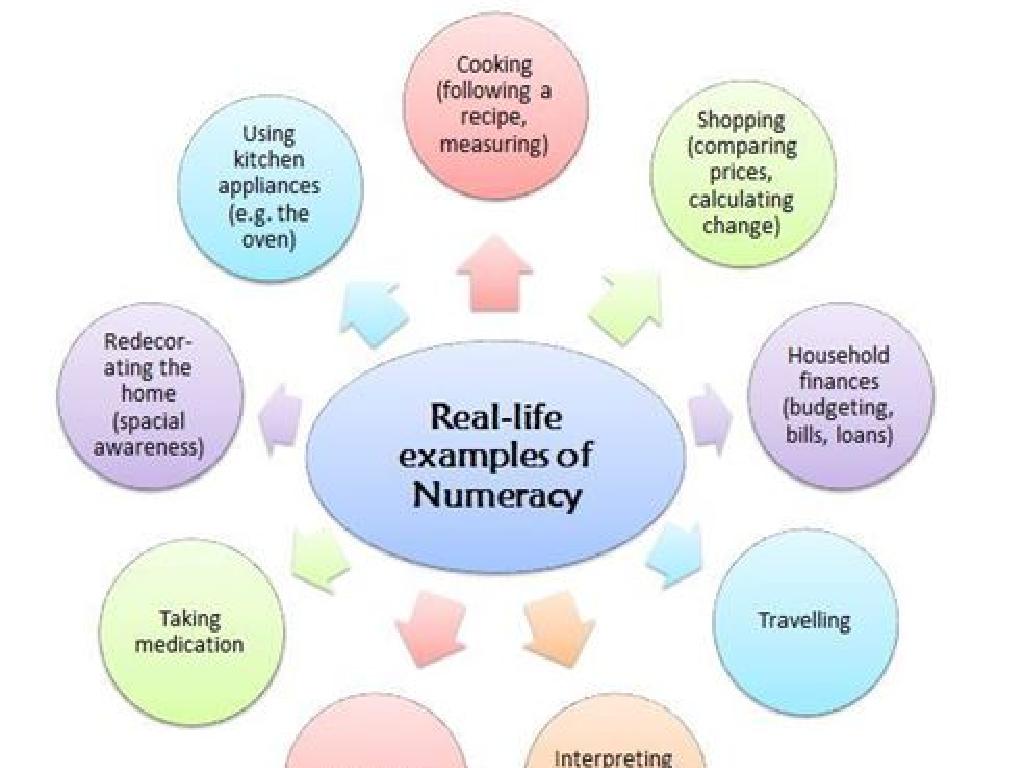Graph A Two-Variable Equation
Subject: Math
Grade: Seventh grade
Topic: Two-Variable Equations
Please LOG IN to download the presentation. Access is available to registered users only.
View More Content
Graphing Two-Variable Equations
– Basics of two-variable equations
– An equation with two variables, like x and y, represents a line on a graph.
– Foundation for graphing
– Understanding equations helps us plot graphs accurately.
– Graphing’s real-life applications
– Used in budgeting, construction, and science experiments.
– Activity: Plotting points
|
This slide introduces students to the concept of two-variable equations and their importance in graphing. Start by explaining that a two-variable equation involves two different variables, typically x and y, and these can be plotted on a graph to represent a line. Emphasize how mastering these equations is crucial for creating accurate graphs. Discuss how graphing is not just a mathematical tool but is also used in various real-life scenarios such as budgeting personal finances, planning in construction, or analyzing data in science experiments. Conclude with an activity where students will practice plotting points on a graph to create a line from a two-variable equation. Provide several equations for students to work on and graph. This hands-on activity will help solidify their understanding of the relationship between equations and their graphical representations.
Graphing Two-Variable Equations
– Define two-variable equation
– An equation with two different variables, e.g., y = 2x + 3
– Examples of two-variable equations
– For instance, y = x + 1 or 2x – 3y = 6
– Variables on axes explained
– Typically, x is independent, y is dependent variable
– Graphing equations practice
|
Begin with the definition of a two-variable equation, emphasizing the presence of two variables that change in relation to each other. Provide clear examples that students can relate to, such as simple linear equations. Explain the convention of placing the independent variable (x) on the horizontal axis and the dependent variable (y) on the vertical axis. Conclude with an activity where students graph a given two-variable equation on a coordinate plane to visualize the relationship between x and y. This will help solidify their understanding of how equations represent relationships between quantities.
The Coordinate Plane: Plotting Points
– Understand the x-axis and y-axis
– The x-axis is horizontal, y-axis is vertical
– Learn to plot points on the plane
– Each point is placed using coordinates (x, y)
– Grasp the concept of ordered pairs
– Ordered pairs determine the exact location on the plane
– Practice plotting with examples
|
This slide introduces students to the fundamental concept of the coordinate plane, which is essential for graphing two-variable equations. Begin by explaining the horizontal (x-axis) and vertical (y-axis) lines that compose the coordinate plane, ensuring students understand their perpendicular relationship. Next, demonstrate how to plot points by locating the position on the x-axis, then moving vertically to the corresponding y-value. Emphasize the importance of ordered pairs (x, y) as a set of instructions for finding points on the plane. Provide several examples for students to practice plotting points, such as (2,3), (-1,4), and (0,-2), and encourage them to plot these points as part of an in-class activity.
Plotting Two-Variable Equations
– Convert equations to points
– Use the equation to find coordinate pairs
– Plot points using a values table
– Each pair represents a point on the graph
– Connect the dots to form the graph
– Draw a line through the points to see the equation’s graph
|
This slide is aimed at teaching students how to graph a two-variable equation by converting it into a set of points. Start by explaining how to substitute values into the equation to get coordinates. Then, show how to organize these coordinates into a table of values. Students will plot these points on a graph and connect them to visualize the equation’s graph. Emphasize that the points should form a straight line for linear equations. Provide examples of different equations to plot and encourage students to try plotting both simple and more complex equations.
Graphing y = mx + b: Slope-Intercept Form
– Understand slope-intercept form
– y = mx + b, where m is slope, b is y-intercept
– Identify slope (m) and y-intercept (b)
– Slope (m) is rise over run, y-intercept (b) is where line crosses y-axis
– Graph a line with slope and y-intercept
– Start at y-intercept (b), follow slope (m) to plot line
– Practice with real examples
– Use examples like y = 2x + 3 to apply concepts
|
This slide introduces students to the concept of graphing linear equations in the slope-intercept form, y = mx + b. Emphasize that ‘m’ represents the slope, which is the rate of change, and ‘b’ is the y-intercept, the point where the line crosses the y-axis. Demonstrate how to graph a line by first plotting the y-intercept on the y-axis and then using the slope to find other points on the line. Provide practice examples for students to apply these concepts, such as graphing the equation y = 2x + 3, and encourage them to try plotting points and drawing the line. This will help solidify their understanding of how equations translate into visual graphs.
Graphing a Two-Variable Equation: Practice Example
– Walk through a sample problem
– Let’s solve y = 2x + 3 together
– Graph the equation step by step
– Plot the y-intercept (0,3), then use slope to find other points
– Discuss checking points’ correctness
– Substitute x and y into the equation to verify
– Class activity: Practice graphing
– Each student will graph a unique equation
|
This slide is designed to guide students through the process of graphing a two-variable equation. Start with a sample problem, such as y = 2x + 3, and demonstrate how to plot the y-intercept on the graph. Next, show how to use the slope to find additional points on the line. Emphasize the importance of checking the correctness of points by substituting them back into the equation. For the class activity, provide each student with a different two-variable equation to graph. This will help them apply the step-by-step process independently while allowing for a variety of examples to be discussed as a class. Provide detailed guidelines for the teacher on how to assist students who may struggle and offer additional practice problems for those who finish early.
Class Activity: Graphing Two-Variable Equations
– Receive a worksheet with equations
– Graph three equations independently
– Class review of the graphs
– Compare different students’ graphs
– Discuss challenges encountered
– Share difficulties and clarify doubts
|
This activity is designed to reinforce students’ understanding of graphing two-variable equations. Distribute worksheets containing various equations for the students to work on. Each student should graph at least three equations on graph paper, ensuring they plot points accurately and draw the line that represents the equation. After completing the task, gather as a class to review the graphs. This will allow students to see different approaches and understand common errors. Encourage students to discuss any difficulties they faced during the activity. As a teacher, be prepared to address misconceptions and provide additional examples to clarify the graphing process. Possible variations of the activity could include pairing students for peer review, using digital graphing tools, or creating a gallery walk where students observe and critique each other’s work.
Graphing Two-Variable Equations: Recap & Homework
– Review graphing two-variable equations
– Emphasize the need for practice
– Practice solidifies understanding and skills
– Homework: Graph more equations
– Solve provided equations and plot them
– Share your graphs next class
– Be prepared to discuss your results
|
As we conclude today’s lesson on graphing two-variable equations, it’s important to recap the steps we’ve learned. Emphasize to students that mastering graphing requires practice, much like learning a musical instrument or a sport. For homework, students are assigned to graph additional two-variable equations, which will help reinforce their skills. Encourage them to be thorough and to check their work for accuracy. In the next class, we’ll review their graphs together, allowing students to share their work and discuss any challenges they encountered. This peer review process will not only help them learn from each other but also build their confidence in graphing.






